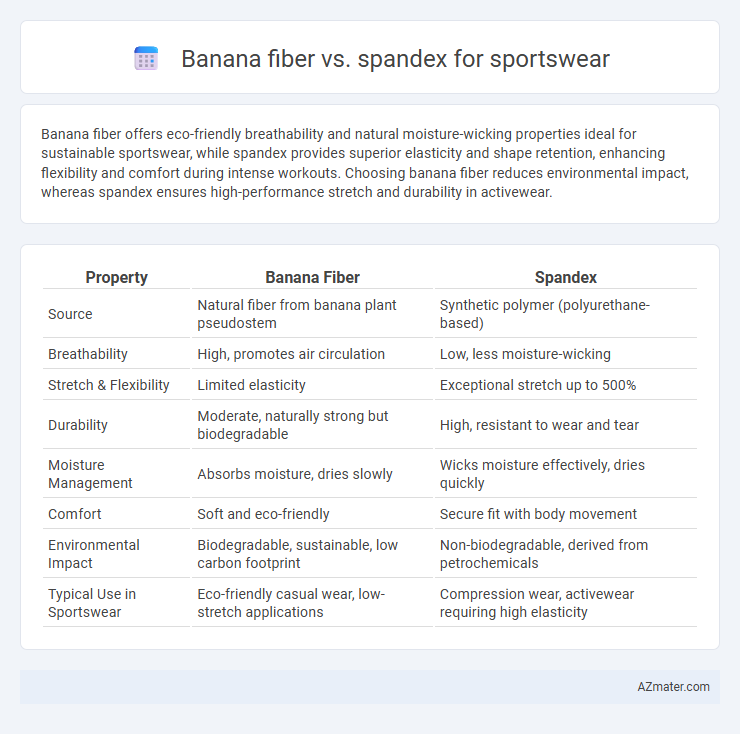Banana fiber offers eco-friendly breathability and natural moisture-wicking properties ideal for sustainable sportswear, while spandex provides superior elasticity and shape retention, enhancing flexibility and comfort during intense workouts. Choosing banana fiber reduces environmental impact, whereas spandex ensures high-performance stretch and durability in activewear.
Table of Comparison
| Property | Banana Fiber | Spandex |
|---|---|---|
| Source | Natural fiber from banana plant pseudostem | Synthetic polymer (polyurethane-based) |
| Breathability | High, promotes air circulation | Low, less moisture-wicking |
| Stretch & Flexibility | Limited elasticity | Exceptional stretch up to 500% |
| Durability | Moderate, naturally strong but biodegradable | High, resistant to wear and tear |
| Moisture Management | Absorbs moisture, dries slowly | Wicks moisture effectively, dries quickly |
| Comfort | Soft and eco-friendly | Secure fit with body movement |
| Environmental Impact | Biodegradable, sustainable, low carbon footprint | Non-biodegradable, derived from petrochemicals |
| Typical Use in Sportswear | Eco-friendly casual wear, low-stretch applications | Compression wear, activewear requiring high elasticity |
Introduction to Sustainable Sportswear Fabrics
Banana fiber offers a renewable, biodegradable alternative for sportswear, providing natural breathability and moisture-wicking properties ideal for activewear. Spandex, a synthetic fiber known for its exceptional elasticity and shape retention, remains popular for performance sportswear but poses environmental challenges due to its petrochemical origins. The growing demand for sustainable sportswear promotes the integration of banana fiber, reducing reliance on synthetic materials like spandex and enhancing eco-friendly fabric innovation.
What is Banana Fiber?
Banana fiber is a natural textile fiber extracted from the pseudo-stems of banana plants, known for its eco-friendly and biodegradable properties. It offers breathable, durable, and moisture-wicking qualities, making it suitable for sustainable sportswear applications. Compared to spandex, banana fiber provides a more environmentally conscious alternative with moderate elasticity and excellent comfort for activewear.
What is Spandex?
Spandex is a synthetic fiber known for its exceptional elasticity, commonly used in sportswear to provide stretch and comfort during physical activities. Its ability to stretch up to five times its original length without losing shape makes it ideal for high-performance apparel requiring flexibility and durability. Unlike banana fiber, which is a natural, biodegradable fabric, spandex offers superior moisture-wicking properties and a snug fit, enhancing athletic performance.
Environmental Impact: Banana Fiber vs Spandex
Banana fiber is a biodegradable, renewable resource derived from agricultural waste, making it an eco-friendly option with minimal environmental footprint compared to spandex, which is a synthetic, petroleum-based material with a high carbon footprint and limited biodegradability. The production of banana fiber involves fewer harmful chemicals and lower energy consumption, while spandex manufacturing releases toxic emissions and contributes significantly to microplastic pollution in water systems. Choosing banana fiber over spandex for sportswear supports sustainable practices by reducing non-renewable resource dependence and minimizing long-term ecological damage.
Moisture-Wicking and Breathability Comparison
Banana fiber offers superior moisture-wicking properties by naturally absorbing sweat and allowing quick evaporation, enhancing comfort during intense physical activity. In contrast, spandex provides excellent stretch but lacks effective moisture management, often retaining sweat against the skin. The breathability of banana fiber, derived from its porous structure, surpasses spandex, making it a more breathable and eco-friendly choice for sportswear.
Comfort and Stretch: Performance Differences
Banana fiber offers natural breathability and moisture-wicking properties, enhancing comfort during intense physical activities, while spandex provides superior elasticity and stretch, allowing for a full range of motion and dynamic support. Sportswear incorporating banana fiber tends to be more environmentally sustainable and hypoallergenic, although it may lack the high stretch recovery found in spandex blends. Combining banana fiber with spandex can optimize performance by balancing natural comfort with enhanced flexibility and durability.
Durability and Maintenance
Banana fiber offers high durability for sportswear due to its natural strength and resistance to wear, making it suitable for repeated use and laundering. Spandex excels in elasticity and flexibility but can degrade faster with frequent washing and exposure to heat or harsh detergents. Maintenance of banana fiber sportswear typically involves gentle washing to preserve fiber integrity, while spandex requires careful handling to avoid loss of stretch and fabric breakdown.
Cost Analysis: Banana Fiber vs Spandex
Banana fiber offers a cost-effective alternative to spandex in sportswear manufacturing due to its natural abundance and lower production expenses, reducing overall material costs. Spandex, while providing superior elasticity and comfort, typically incurs higher costs from synthetic processing and petrochemical dependency. Choosing banana fiber can significantly lower investment in raw materials but may require modifications in fabric blends to maintain performance standards found in spandex-based sportswear.
Market Trends and Consumer Preferences
Banana fiber is gaining traction in sportswear due to its sustainability, biodegradability, and natural breathability, appealing to eco-conscious consumers seeking environmentally friendly athletic apparel. In contrast, spandex remains dominant for its exceptional elasticity, moisture-wicking properties, and durability, meeting the high-performance demands of athletes and fitness enthusiasts. Market trends indicate a growing niche preference for banana fiber blends that combine comfort with sustainability, while spandex continues to lead in technical innovation and widespread acceptance in mainstream sportswear.
Future Potential of Banana Fiber in Activewear
Banana fiber exhibits strong potential for sustainable activewear due to its natural breathability, moisture-wicking properties, and biodegradability, positioning it as an eco-friendly alternative to synthetic fibers like spandex. Advances in banana fiber processing are enhancing its elasticity and durability, making it increasingly viable for high-performance sportswear applications. As consumer demand for sustainable textiles rises, banana fiber could disrupt the activewear market by offering a renewable material that meets functional requirements without compromising environmental responsibility.

Infographic: Banana fiber vs Spandex for Sportswear
 azmater.com
azmater.com